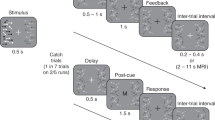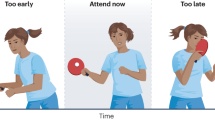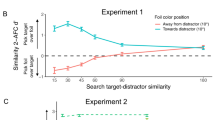Abstract
Virtually all behavioral and neurophysiological studies have shown that sustained (endogenous, conceptually driven) attention enhances perception. But can this enhancement be held indefinitely? We assessed the time course of attention's effects on contrast sensitivity, reasoning that if attention does indeed boost stimulus strength, the strengthened representation could result in stronger adaptation over time. We found that attention initially enhances contrast sensitivity, but that over time sustained attention can actually impair sensitivity to an attended stimulus.
This is a preview of subscription content, access via your institution
Access options
Subscribe to this journal
Receive 12 print issues and online access
$209.00 per year
only $17.42 per issue
Buy this article
- Purchase on Springer Link
- Instant access to full article PDF
Prices may be subject to local taxes which are calculated during checkout



Similar content being viewed by others
References
Carrasco, M., Ling, S. & Read, S. Nat. Neurosci. 7, 308–313 (2004).
Liu, T., Pestilli, F. & Carrasco, M. Neuron 45, 469–477 (2005).
Ling, S. & Carrasco, M. Vision Res. 46, 1210–1220 (2006).
Dosher, B.A. & Lu, Z.L. Vision Res. 40, 1269–1292 (2000).
Pestilli, F. & Carrasco, M. Vision Res. 45, 1867–1875 (2005).
Reynolds, J.H., Pasternak, T. & Desimone, R. Neuron 26, 703–714 (2000).
Martinez-Trujillo, J. & Treue, S. Neuron 35, 365–370 (2002).
Ohzawa, I., Sclar, G. & Freeman, R.D. Nature 298, 266–268 (1982).
Langley, K. Spat. Vis. 16, 77–93 (2002).
Greenlee, M.W., Georgeson, M.A., Magnussen, S. & Harris, J.P. Vision Res. 31, 223–236 (1991).
Foley, J.M. & Boynton, G.M. Vision Res. 33, 959–980 (1993).
Movshon, J.A. & Lennie, P. Nature 278, 850–852 (1979).
Brefczynski, J.A. & DeYoe, E.A. Nat. Neurosci. 2, 370–374 (1999).
Alais, D. & Blake, R. Nat. Neurosci. 2, 1015–1018 (1999).
Lou, L. Perception 28, 519–526 (1999).
Acknowledgements
We would like to thank T. Liu and all the members of the Carrasco lab for helpful discussions. This work was funded by the US National Institutes of Health (S.L.).
Author information
Authors and Affiliations
Contributions
Both authors contributed equally to this project.
Corresponding author
Ethics declarations
Competing interests
The authors declare no competing financial interests.
Supplementary information
Rights and permissions
About this article
Cite this article
Ling, S., Carrasco, M. When sustained attention impairs perception. Nat Neurosci 9, 1243–1245 (2006). https://doi.org/10.1038/nn1761
Received:
Accepted:
Published:
Issue Date:
DOI: https://doi.org/10.1038/nn1761
This article is cited by
-
Tracking momentary fluctuations in human attention with a cognitive brain-machine interface
Communications Biology (2022)
-
Periodic attention operates faster during more complex visual search
Scientific Reports (2022)
-
Differential impact of endogenous and exogenous attention on activity in human visual cortex
Scientific Reports (2020)
-
How visual spatial attention alters perception
Cognitive Processing (2018)
-
Motion Alters Color Appearance
Scientific Reports (2016)



